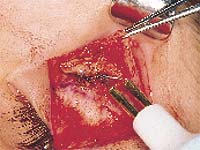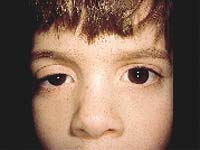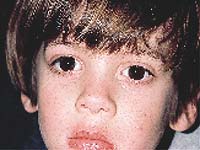Management of congenital ptosis
While it is a real challenge to treat, ophthalmologists can achieve excellent results.
Levator maldevelopment (dysmyogenic) ptosis is the most common type of ptosis seen in childhood and is caused by primary dystrophy of the levator muscle. Mueller's superior tarsal muscle is normal. Approximately 75% of congenital ptosis is unilateral. Congenital ptosis is usually a pure congenital ptosis. However, it may be associated with superior rectus weakness, Marcus-Gunn synkinetic jaw winking ptosis and blepharophimosis syndrome. Amblyopia is found in about 20% of patients, usually secondary to convergent strabismus, high astigmatism and anisometropia. Anderson and Baumgartner report rare instances of amblyopia due solely to the ptotic occlusion of the pupil.
Preoperative evaluation
 ---Levator and Mueller's muscle dissected off conjunctiva with a disposable cautery. Methylene blue marks the superior tarsal border.
---Levator and Mueller's muscle dissected off conjunctiva with a disposable cautery. Methylene blue marks the superior tarsal border.
The amount of ptosis is measured as the distance between the upper and lower eyelid margins with the brow held in a relaxed position. In bilateral ptosis, the amount of ptosis is determined by the marginal reflex distance (MRD), that is, the light reflects from the cornea to the upper lid. The normal MRD is +4 to 4.5 mm, with the normal eyelid position being 1.5 mm to 2 mm from the superior limbus.
The levator muscle function is the measurement of the upper lid excursion from down gaze to far up gaze with the eyebrow held in a fixed position to eliminate frontalis muscle action. The height and contour of the upper eyelid creases are observed to determine the point of action and the point of insertion of the levator aponeurosis. Lacrimal secretory function, Bell's phenomenon, strabismus, visual acuity, synkinetic jaw winking and the general status of the patient need to be evaluated in the work up of the ptosis patient.
We have traditionally classified ptosis as mild (2 mm), moderate (3 mm) and severe (4 mm). Levator function is classified as excellent (13-15 mm), very good (10-13 mm), good (8-10 mm), fair (5-7 mm) and poor (4 mm or less). The amount of ptosis and levator function determine the amount of aponeurosis and levator muscle resection, with the levator function being the most important of the two.
The earliest age to repair a congenital ptosis is when the patient is 4 to 5 years old. At this age, the eyelid tissues are larger, and the patients are very cooperative to ensure accurate preoperative measurements. The only exception occurs when the pupillary axis is completely covered by the eyelid where it should be elevated on an urgent basis to prevent deprivational amblyopia. Patients are seen multiple times to get consistent measurements prior to surgery.
Informed consent
As in any surgical procedure, informed consent is especially important, because expectations of success are high. Therefore, a detailed explanation of the procedure and complications is very important. Presentation of a positive end result is most realistic in a patient with mild ptosis and good levator function, as opposed to a patient with severe ptosis and poor levator function. Therefore, correspondingly, complications of overcorrection, undercorrection, lid lag, lagophthalmus and asymmetric blinking are discussed.
Surgery for congenital ptosis
|
|
|
|
|
|
The best surgical approach for congenital ptosis [excluding patients with severe ptosis and poor levator function (4 mm or less), which requires a frontalis sling] is a levator aponeurotic or muscle resection via the skin approach. Familiarity with this approach will lead toward more consistently good results. The tables show the amount of levator resection for a given amount of ptosis and levator function with emphasis on the levator function. The measurement of the amount of resection of the levator aponeurosis or muscle is from the disinserted end proximal with the muscle on very little to no stretch. The procedure is as follows:
- Under general anesthesia, intubation and sterile skin preparation, the upper eyelid crease is marked at the desired height so it can be symmetrical with the opposite upper eyelid crease.
- 1% Xylocaine (lidocaine HCl, Astra) with epinephrine, 0.75% Marcaine (bupivacaine HCl, Winthrop) and Wydase (hyaluronidase, Wyeth) are injected subcutaneously along the eyelid crease, as well as subconjunctivally.
- The skin is incised along the methylene blue marks with a #15 blade. A Stevens scissors is used to buttonhole the orbicularis muscle at the superior tarsal border and extend medial and laterally the length of the tarsal plate.
- The pretarsal skin and orbicularis are dissected off the upper half of the tarsal plate.
- With a double-pronged skin hook pulling inferiorly on the skin-muscle flap, a Stevens scissors is used to sharply dissect underneath preseptal skin and orbicularis superiorly in a plane underneath the orbicularis muscle and anterior to the levator muscle.
- With gentle pressure on the inferior lid, the orbital septum and preaponeurotic fat are prolapsed forward.
- The orbital septum is opened, and the preaponeurotic fat is prolapsed, excised and cauterized.
- A double battery, hand-held cautery is used to dissect up levator aponeurosis along with Mueller's muscle from conjunctiva as superior as necessary to accomplish the predetermined levator-Mueller's muscle resection based upon the tables. The medial and lateral horns of levator are only cut as necessary to allow resection of the amount of levator desired.
- Three double-armed 6-0 silks are placed through the anterior one-half of the tarsal plate, central, nasal and temporal, 4 to 5 mm from the superior tarsal border and back through the levator Mueller's muscle with the levator muscle being placed inferiorly with very little stretch.
- The amount of levator resection is measured from the inferior edge of the levator muscle, which is held in the forceps. The eyelid height and contour are evaluated, and adjustments are made.
- The excess levator and Mueller's muscle are excised. Two to three millimeters of skin are then excised superior to the incision before closure.
- Four 6-0 chromic catgut sutures form the eyelid crease by suturing pretarsal orbicularis to levator aponeurosis. The skin is closed with a running 6-0 fast absorbing suture as well as some interrupted sutures.
- A 4-0 silk Frost suture is placed in the lower eyelid margin and taped to the forehead for ocular protection for 24 hours, and the eye is double patched.
Postoperatively, the patch is removed the next day, and the eye is lubricated with a lubricating ointment for several days followed by artificial tears for a week or so as needed.
For Your Information:
- Mark R. Levine, MD, can be reached at 1611 S. Green Rd., Ste. 306A, S. Euclid, OH 44121; (216) 291-9770; fax: (216) 291-0550; e-mail: mark.levine@gte.net. Dr. Levine does not have a direct financial interest in any of the products mentioned in this article, nor is he a paid consultant for any company mentioned.



